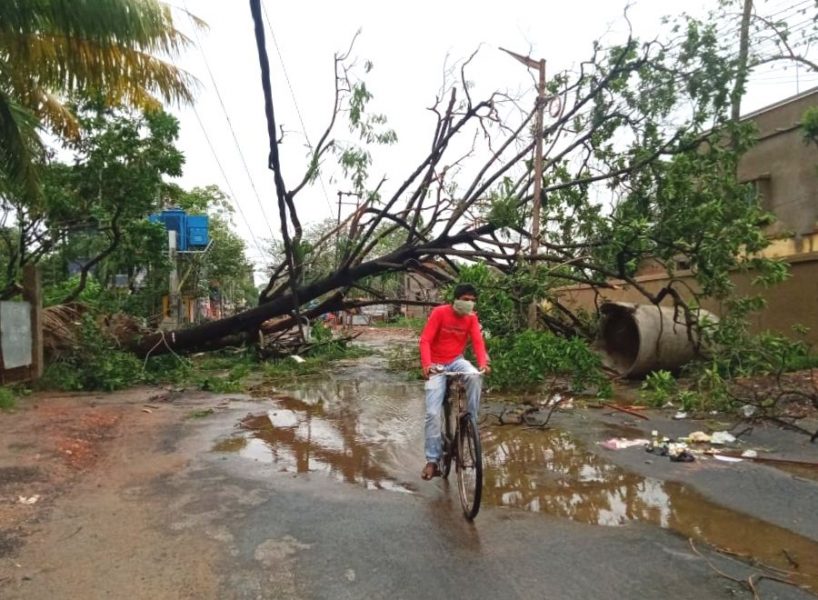
Amphan’s fury conjures up memories of 1737 Bengal cyclone

On Thursday Kolkata woke up to its dreaded nightmare. From the ear-splitting sound of the gale that was persistently pounding on the city’s concrete jungle the previous night, the cowering residents could well fathom the devastation being unleashed outside.
The rude shock came in the morning, when they found the modern-day lifeline, the net and cellular connectivity either wobbly, in few places, or completely snapped in most.
The other electronic window to the outside world, the television screen, also drew a blank. To add to the woes, there were power outages in most localities.
Related news: Capturing the trail of destruction left by Cyclone Amphan in Bengal
Desperate for information, a few curious citizens ventured out of their homes to witness the magnitude of destruction. But they could not go too far beyond their locality as most roads were blocked by fallen trees, uprooted electric posts, torpedoed road barriers, displaced signboards and hoardings.
Compounding the barriers, several localities were also inundated as the city previous night witnessed a record downpour of 244.2 millimetre. A vast expanse of even Kolkata airport, including its runway was under water.
Park Street, Regent Park, Bidhannagar, Gariahat, Tollygunge, Behala, Sobhabazar, Bagbazar, Dumdum and Maheshtala —from south to north and east to west, the entire city was strewn with ravaged remains of a destruction it had never seen in centuries, if not ever.
At least seven worn-out buildings and a few thousand trees which were witnesses to many a triumph and disaster of the ageing city, caved in, unable to withstand the fury.
Many, including Chief Minister Mamata Banerjee compared the catastrophe to the similar dance of destruction Kolkata had witnessed over two centuries ago, on October 11, 1737.
Related news: Centre’s ‘neglect’ of Bengal during Amphan: Social media erupts in anger
As per the chronicles, the furious storm had killed over 3,000 people in what was then an emerging township on the banks of Hoogly. It had also hammered down two prominent landmarks of the erstwhile Kolkata — St. Anne’s cathedral and the gem-studded spire of Gvoindaram temple.
The path of the whirling wind referred to as ‘1737 Bengal cyclone’ bore uncanny resemblance to the track of the latest Amphan. Emerging from the depths of the Bay of Bengal in the Sunderbans, almost like Wednesday’s cyclonic storm, it had also traversed through Kolkata to enter Bangladesh.
The details of the brutal onslaught remain snappy till date because connectivity tools were not so developed during those formative days of the city.
Unfortunately, even in the 21st century, Kolkata people faced the same information challenge due to the connectivity handicap. The actual extent of damage done by Amphan started unfolding before its citizens only after the mobile networks and other modern day information gadgets started stirring back to life by the evening.
As the information started trickling in again, it was confirmed that 15 persons lost their lives in the city, at least six of whom died due to electrocution.
Hundreds of shanties in the city’s slums were flattened rendering thousands homeless. Even the well offs in the high rises were not left unscathed.
The gushing wind ripped through the windows of many swanky apartments, damaging the kempt interiors.
“Water gushed into our bedrooms through the ripped windows and my entire interior was rampaged by the blustery weather,” said Kaustari Mitra, a seventh-floor resident of an upscale apartment, the Genex Valley in Joka.
Related news: Revisiting Amphan’s predecessor, the Super Cyclone of 1999
Many vehicles, including buses, were also upturned.
Kolkata police and municipality workers toiled throughout the day and cleared the mess on the CIT Road, Shakespeare Sarani, Darga Road, Gariahat Road, Dhakuria Bridge and many other thoroughfares by late evening. But, the city was barely struggling back to its feet.
Kolkata Municipality sources said it would take another one or two days for the ‘City of joy’ to return to its rhythm. Will it?


